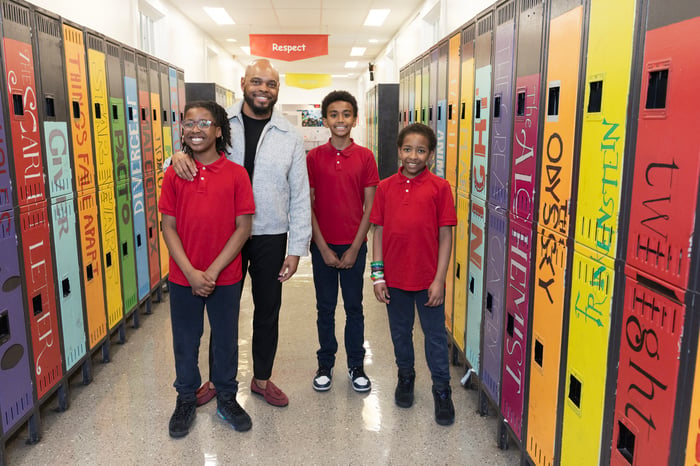Four Pillars of Inclusive Teaching: A Leader's Guide to Building Capacity
Administrators • 8 min read • Jul 28, 2025 5:08:26 PM • Written by: Sarah Sandelius

As you plan for next year's professional development priorities, you're likely asking: What will actually move the needle on inclusive practices in my school? Through our THRIVE Assessment of Inclusive Educational Practices (TIPA), we've identified the specific practices that distinguish highly effective inclusive teachers.
These four pillars align directly with our THRIVE Framework for Quality Special Education. When teachers strengthen these core areas, we see measurable improvements in student outcomes and program quality across entire schools and districts.
For leaders planning ahead, this data can help you target your professional development investments where they'll have the greatest impact on authentic inclusion. In this blog, we outline these pillars, offer some "look fors" for leaders conducting instructional rounds, and offer considerations for capacity building of your team.
Pillar 1: Building a Culture of Collaboration
THRIVE Connection: Element One Culture of Inclusion
Through our TIPA assessment, we see that the most effective inclusive educators consistently score highest on collaboration indicators. This aligns perfectly with the THRIVE Framework's first element: establishing a culture where serving diverse learners is everyone's responsibility.
When teachers embrace collaborative responsibility for all students, leaders will see reduced silos between general and special education, more efficient use of support staff, and improved outcomes for students with disabilities.
|
TIPA Indicators |
Leader Look Fors |
|
|
Professional Development Implications: Building a collaborative culture requires foundational work in inclusive mindsets and shared responsibility. Our Inclusive Practices for Teachers series builds these core beliefs and skills that underpin effective teamwork around student success.

Pillar 2: Data-Driven Understanding of Student Needs
THRIVE Connection: Element 2 Student-Centered Curriculum & Instruction
One of the most telling factors is how high-performing inclusive educators approach assessment and data use. This directly supports THRIVE's second element: delivering instruction that provides meaningful access to grade-level content for diverse learners.
Teachers who use data strategically to understand and remove barriers create more efficient interventions and see better student outcomes. This is particularly critical for your special education compliance and student achievement goals.
|
TIPA Indicators |
Leader Look Fors |
|
|
Professional Development Implications: Strategic data use for inclusion requires deep understanding of Universal Design for Learning principles and differentiated assessment strategies. These skills help teachers move from compliance-driven data collection to meaningful, student-centered decision making.

Pillar 3: Evidence-Based Inclusive Instruction
THRIVE Connection: Element 2 Student-Centered Curriculum & Instruction and Element 3 Shared Understanding of Special Education
What sets apart the highest-scoring educators in our TIPA assessment is their proactive approach to inclusive instruction. This connects directly to THRIVE's emphasis on evidence-based practices and understanding how to meet individual student needs through specialized instruction.
Teachers who excel in using evidence-based strategies create more efficient classrooms, reduce behavior challenges, and improve outcomes for all students—not just those with disabilities. This is where you'll see the biggest return on professional development investment.
|
TIPA Indicators |
Leader Look Fors |
|
|
Professional Development Implications: Excellence in inclusive instruction requires deep expertise in differentiating instruction, implementing Universal Design for Learning, and collaborating effectively around student-specific needs. Our Inclusive Practices for Teachers series develops these interconnected skills through job-embedded support and practical application.

Pillar 4: Meaningful Engagement and Professional Growth
THRIVE Connection: Element Five Meaningful Family Partnerships and Element Three Shared Understanding of Special Education
The most inclusive educators share a crucial characteristic: they actively engage families as partners and continuously refine their practices based on student outcomes. This directly supports THRIVE's emphasis on family partnerships and deep understanding of special education requirements.
Teachers strong in this area create more effective IEP teams, have better family relationships, and show continuous improvement in their inclusive practices. This translates to fewer complaints, better compliance, and improved student outcomes.
|
TIPA Indicators |
Leader Look Fors |
|
|
Professional Development Implications: Sustainable, inclusive practices require ongoing professional growth in family engagement, reflective practice, and continuous improvement. These skills work together to create educational environments where both students and teachers thrive over time.

Strategic Planning for Next Year: Using Data to Drive Decisions
These four pillars work together to create classrooms where every student can thrive, directly supporting the comprehensive approach outlined in our THRIVE Framework. They're not separate initiatives—they're interconnected practices that reinforce each other.
For leaders planning professional development priorities:
Start with assessment. Use our TIPA assessment to gather baseline data on your teachers' current inclusive practices. This data will help you:
- Identify which pillars need the most attention across your staff
- Target your professional development investments for maximum impact
- Create differentiated support plans for teachers at different skill levels
- Measure growth over time on different questions that align with your key schoolwide initiatives
Align with your THRIVE journey. Whether you're just beginning to implement THRIVE elements or looking to deepen existing practices, these four pillars provide a clear pathway for teacher development that supports system-wide improvement.
Consider comprehensive support. Our Inclusive Practices for Teachers professional learning series addresses all four pillars through:
- Job-embedded coaching and support
- Practical strategies grounded in THRIVE principles
- Collaborative learning that builds school culture
- Tools and resources for immediate implementation
Ready to gather your baseline data?
Our TIPA assessment takes teachers about 15 minutes to complete and provides immediate insights into current practices. Download a copy by clicking the simplified reflection tool below to get started, or contact us about implementing the full TIPA assessment as part of your strategic planning process.
The Ability Challenge's THRIVE Framework provides a comprehensive systems approach to special education excellence. Our Inclusive Practices for Teachers series builds the individual capacity needed to implement those systems effectively. Together, they create the conditions where all students can truly thrive.
It's never to late to start your special education improvement journey!
Sarah Sandelius
Our Latest
Related Articles

October 9, 2024 | Administrators
The LEA Representative: A Guide for School Leaders
Discover how Local Educational Agency (LEA) representatives can transform IEP meetings into powerful...

June 17, 2024 | Administrators
Decoding the Difference: What Administrators Need to Know about MTSS vs. Special Education
Learn the distinctions between MTSS and special education frameworks, and expert strategies for scho...

August 28, 2025 |
New School Year, New Tools for Success: The THRIVE Systems Leadership Cohort Toolkit
Transform your school's approach to special education with the THRIVE Systems Leadership Cohort Tool...

